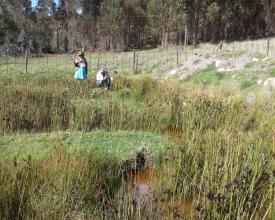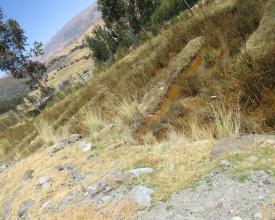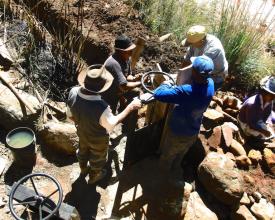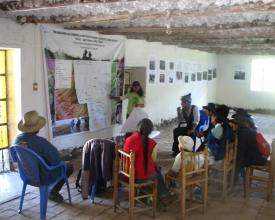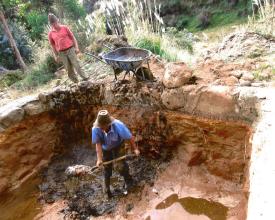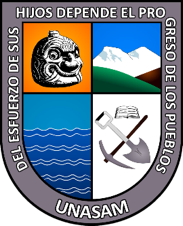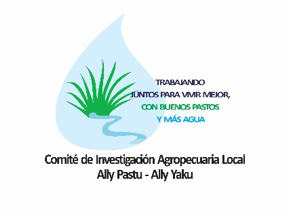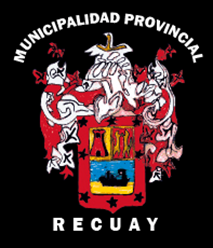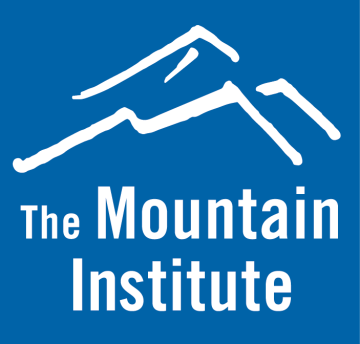
Bioremediation in the Cordillera Blanca Campesino Community, Peru
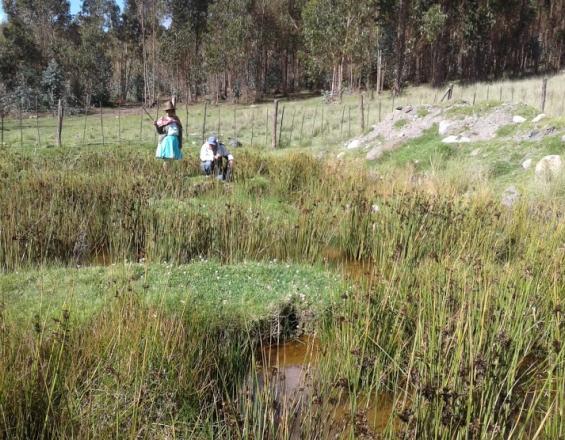
The community, located in Huascarán National Park, is being affected by the natural contamination of the waters of the Negro River because glacial retreat has left rocks exposed in the mountains that generate acidification and dissolution of metals in the water due to rainfall runoff. This phenomenon is detrimental to the community members who are engaged in extensive cattle ranching on natural pastures. This initiative, implemented by the community and the Mountain Institute, involved participatory analysis and monitoring of water quality, training of local researchers, and a search for technological alternatives to solve the problem. Finally, bioremediation was chosen, whereby the water is purified by passing it through a series of rustic ponds in which sediments are decanted and then the capacity of native plants is used to absorb the contaminants. In this way, the quality of water for human and livestock consumption was improved.
Context
Challenges addressed
- In the Negro River sub-basin, glacial retreat leaves exposed geological formations rich in minerals that oxidize and release metal particles into the water. This phenomenon is called "acid rock drainage" and alters the quality of water in the headwaters of the basins, affecting the lower reaches and endangering the health of people who use the water directly and for productive agricultural and livestock activities (Loayza-Muro et al., 2014).
- The problem is exacerbated during the dry season because, in the absence of rainfall, the inhabitants are forced to collect water from the river, depending entirely on this source for the development of their socioeconomic activities.
- Sediment management and treatment is one of the challenges for local researchers and community leaders, and at the same time an opportunity for academics to collaborate in finding a solution.
Location
Process
Summary of the process
The Local Agricultural Research Committee or CIAL (BB1) implemented a Participatory Action Research-PAR (BB2) with the support of scientific organizations to find a solution to the problem of water acidification, a priority for the community. The PRA integrated local knowledge with scientific knowledge to design a bioremediation technique (BB3) that has successfully solved the problem.
Building Blocks
The Local Agricultural Research Committee
The Comité de Investigación Agropecuaria Local (CIAL) was established in 2000 and its members were chosen at a community assembly. The criteria established by the community members themselves to choose the local researchers were based on certain characteristics such as being observant, committed, responsible and punctual. The CIAL began with 16 members, both men and women. Its creation was based on the principles of Participatory Action Research (PAR). The CIAL and the IM initially carried out participatory research between 1999 and 2001 to recover pastures for cattle, starting with one hectare ceded by the community for this purpose and ending with 10 hectares thanks to the growing interest of the community members.
In 2010 the CIAL was reactivated with 24 members to carry out research under the name "Good Pasture, Good Water". In 2014 the CIAL was institutionalized in the community, being part of its organizational chart as one of its specialized committees and being included in the community's internal regulations. It is a very active committee, which is in permanent dialogue with its directors and with the entire assembly to report the progress of the research and its proposals, so that they can have the support for the necessary work through the communal tasks.
Enabling factors
- The commitment of its members (although some young people had to withdraw due to other obligations).
- The support and backing of its community leaders.
- The community's level of governance, which is reflected in: (i) its level of planning, the community prepared its Community Development Plan; (ii) the institutionalization of the CIAL in the community's organizational chart and internal regulations; and (iii) the management capacity of the community leaders, who obtained external support (e.g., heavy machinery) to implement the actions.
Lesson learned
-
The process of institutionalizing the committee took much longer than anticipated, from its constitution in 2000 to its recognition in the statute as technical advisors to the community on pasture and water issues.
-
Empowerment and capacity building of committee members in the use of water quality monitoring equipment and data interpretation was key.
-
The initiative responded to a priority need of the community itself, namely water, responding to problems they have had since 1970. As mentioned by CIAL members, "we were always asking ourselves and other institutions why the color of the water and the smell and taste had changed and no one would give us an answer, until we were able to understand and improve the quality of our water" (Vicente Salvador).
-
It is necessary to prepare alternate representatives for the committee, since it demands a lot of time dedication, so some very empowered members left the committee due to their other obligations.
Participatory Action Research
Participatory Action Research (PAR) refers to research based on three pillars: (i) Research: belief in the value and power of knowledge and respect for its different expressions and ways of producing it; (ii) Participation: emphasizing democratic values and the right of people to control their own situations and stressing the importance of a horizontal relationship between the community involved and external organizations; and (iii) Action: a change that improves the community's situation. More than the methodology or techniques used, what distinguishes PRA from other ways of doing research is the commitment to social change and the express search to collaborate with the empowerment of vulnerable groups so that they can decide and manage their own change. The CIAL, with support from the Mountain Institute and the National University of Ancash Santiago Antúnez de Mayolo, carried out a PRA on water quality between 2010 and 2013 that included dialogue of knowledge between local researchers and external specialists, training to measure water quality with field teams that evaluate parameters (PH, conductivity, acidity, dissolved oxygen, and others), and the identification and implementation of the bioremediation solution.
Enabling factors
- Spaces for dialogue between local and academic knowledge, facilitated by participatory research processes and dialogue of knowledge.
- The support of a thesis student from the local university who provided technical support.
- The organization of community leaders, for their management capacity with the provincial municipality.
- The collaboration of the local government, the communal work for the construction of sedimentation ponds.
- The perseverance of the local researchers and the thesis student, from the proposal to the implementation and monitoring.
Lesson learned
- The permanent interaction of the local researchers with the thesis student and the project facilitators generated a process of reflection and collective learning that allowed us to understand the problem, look for alternatives and implement a solution appropriate to the local context.
- Working in coordination with local authorities and the community assembly was fundamental to achieve the approval and support of the community.
- The dialogue of knowledge and the valuation of local knowledge made it possible to find solutions that were presented. For example, the preparation of cattail(Juncos articus) cuttings did not give good results following the proposal of the university specialist, but the technique suggested by the local researchers, who had already tried it in the recovery of native grasses, did work.
- The IAP methodology helps adaptive technical planning. For example, at the beginning of the bioremediation system there was difficulty in controlling the flow of water in the canal. The researchers sought a solution to place gates at the beginning of the sedimentation ponds and wetlands.
Bioremediation
Bioremediation includes the use of organisms to eliminate contaminants from the soil or water. In the bioremediation system, water from the Chonta canal passes first through settling ponds and then through larger ponds where cattails and reeds - local plants - were installed to absorb rust from the water through their roots. Bacteria are also used to reduce the acidity of the water. Finally, the canal provides 120 L of purified water per second for the entire population and was implemented thanks to the collaboration of institutions based on community demand. It was designed under criteria of traditional and scientific knowledge: the appropriate places to build the sedimentation ponds, the wetland area, the selection of plants such as cattails and the technology for transplanting into the wetlands. CIAL members and the community clean the sedimentation ponds once a year between April and May. When the rains start, they let in a minimum flow, only for wetland maintenance and the use of some farmers.
The CIAL monitors water quality in the system twice a year; they mainly measure pH and electrical conductivity.
Enabling factors
- It started from a locally driven process to solve a local priority issue.
- The measure is part of a larger strategy: the Community Development Plan (CDP).
- Organization of local participation through the committee.
- Prior relationship of trust between the community and the Mountain Institute, which supported implementation.
- Continuous monitoring of the quality and proper functioning of the bioremediation system by the committee members.
Lesson learned
- It is necessary to plan the supply of inputs, either by confirming if there are sources to acquire them or if it will be necessary to produce them, such as sulpho-remediating bacteria in the wastewater treatment plants. While the plants do exist, there is not good management and not enough bacteria, so the laboratory needs to produce them especially for installation in wetland ponds.
- The technology also requires rules for the proper use of treated water.
- The operability of the water committee is a key factor and requires institutional strengthening and advice.
- An important role of the committee is to follow up the system through monitoring and maintenance of the infrastructure.
- Implementation needs to be accompanied by training, such as in infrastructure monitoring and maintenance (cleaning of sedimentation ponds and wetlands) and sediment management.
Impacts
- Improved water quality for agricultural and domestic use. Water can now be used for irrigating natural pastures and watering livestock, as well as for human consumption, washing clothes, watering cultivated pastures and vegetables.
- Improved availability and condition of pasture for livestock. The provision of natural pasture for feeding livestock has been improved, the sale of which is used for education, food purchases and other family expenses.
- Improved livestock health
- Recreation of the aquatic ecosystem
Beneficiaries
- Who participated: "Alli Pasto Alli Yacu" Local Agricultural Research Committee (CIAL) and Cordillera Blanca Peasant Community (Canrey Chico sector).
- Social impact: 80 farming families.
Sustainable Development Goals
Story
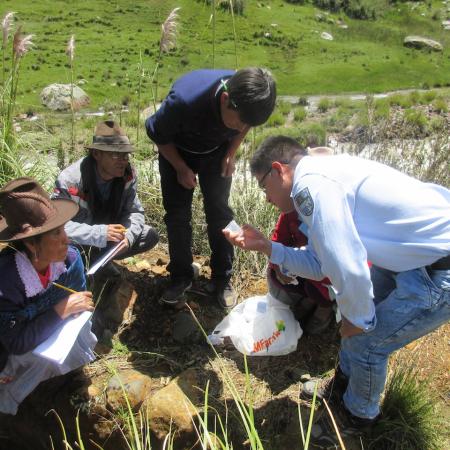
The Cordillera Blanca Campesino Community is the source of important tributaries that supply water to the local population and downstream. Near these water sources are pastures where most of the community members graze cattle and sheep extensively in dry and wet grasslands.
The population began to notice changes in water quality in 1970, after a strong earthquake. This coincided with the beginning of the accelerated retreat of the Andean glaciers. The villagers say that the river used to be black, but its water was crystal clear, there were trout, they could wash, drink and also irrigate. But after that year they noticed the change in color, which is now red and they call it "agua alcaparrosa" (caper water). There are no more trout, they cannot water their pastures or grow crops because the vegetation dries up. For this reason, the community prioritized water quality research. The community has prepared and strengthened its capacities through the CIAL Committee "Allí pasto, Allí Yacu" ("good pasture and good water" in Quechua), which was formed during a project to improve pasture management that the community implemented with the Mountain Institute between 1999 and 2001. With this new initiative, the CIAL has been investigating water quality and has shared the results in community assemblies. The local researchers analyzed possible solutions and opted for bioremediation, which integrated engineering, ecosystem management, and social components, so it is considered "a 'socio-technology.
From the old channel installed on one side of the river, the water travels through a 3 km long network of canals, built in 2014. The system, explains Vicente [Salvador, president of the CIAL], "works like a kind of intestine: the water first passes through some wells where the sediment remains and then travels to other larger wells where cattails and reeds, local plants that absorb rust from the water through their roots, have been planted. Laboratory-grown bacteria are also used to help reduce the acidity of the water. At the end of the process, the canal provides 120 L of purified water per second for the entire population. With that water they can irrigate an area similar to 60 soccer fields, filled with natural grasses that allow them to produce more milk and raise healthy cattle. We have shown that we can heal the river using our ancestral knowledge and also scientific knowledge".
